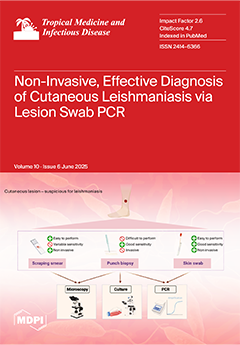Aedes aegypti, the main urban vector of dengue fever, represents a growing public health problem in Nouakchott, the capital of Mauritania. Identifying the factors influencing the distribution and productivity of its breeding sites is essential for the development of effective control strategies. From May 2023 to April 2024, physico-chemical characteristics were recorded and mosquito larvae were collected, using a standard dipping method, from 60 water collections each month during the dry season and twice a month during the rainy season, totaling 294 observations. The larval positivity of water collections and larval abundance of breeding sites over the time were modeled using a random-effect logistic regression model and a negative binomial regression model, respectively. The depth, distance from habitat, type of water collection and exposure to sunlight were statistically significant and independently associated with water collection positivity for
Ae. aegypti larvae (aOR = 5.18, 95%CI [1.66–16.18],
p-value = 0.005; aOR = 0.00, 95%CI [0.00–0.02],
p-value < 0.001; aOR = 252.88, 95%CI [4.05–15,786.84],
p-value = 0.009 and aOR = 0.04, 95%CI [0.01–0.26],
p-value < 0.001, respectively).
Aedes aegypti larval habitats were mainly artificial (90%), temporary (
n = 217 observations), close to dwellings (
n = 114) and shaded (
n = 96). Plastic water tanks (
n = 17, 48.6%), wells (
n = 6, 17.1%) and barrels (
n = 4, 11.4%) were the most common breeding sites. Larval abundance was negatively associated with containers of increasing pH and surface area (aOR = 0.50, 95%CI [0.33–0.75]
p-value = 0.001 and aOR = 0.48, 95%CI [0.27–0.87],
p-value = 0.016, respectively). As
Ae. aegypti mosquitoes are multi-resistant to adult insecticides and dengue has become endemo-epidemic since 2014, vector control should give the priority to the physical removal or treatment of shaded, peridomestic containers—particularly plastic water tanks and barrels—and consider the use of biological larvicides to target breeding sites with low pH and small surface areas.
Full article






